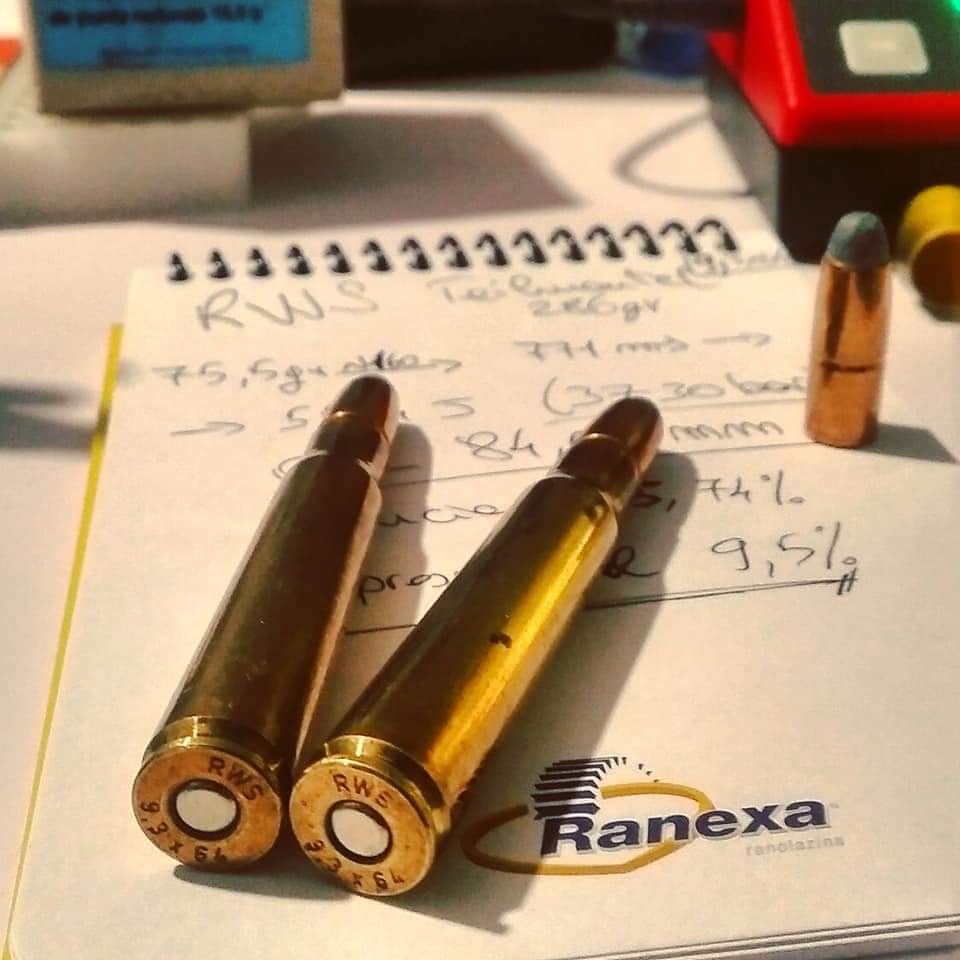
Writing about this caliber is difficult, being almost disappeared. For decades it was the European answer to the presumptuous .375 Holland & Holland spread, Wilhelm Brenneke’s most cared creature. Correct… because if the good 7 × 64 had gave eternal glory to Wilhelm, and the 8 × 64 had brought him one step closer to replacing the valid 8x57JS ordinance, his favorite son, cradled and raised with love, was precisely the 9.3 × 64, the most powerful, futuristic and performing European caliber, conceived and designed for large and very large game. English Big Game Hunting dedicate calibers’ spread had overwhelmed the entire black continent: for over a century and a half anyone who wanted to undermine Buffaloes, Elephants, Rhinos was Forced to employ expensive weapons and cartridges, not always excellently available, and without constant ballistic performances. While excellent British Express rifles had an unassailable reputation, bolt action rifles lacked in power, accuracy and performance, they couldn’t compete with slow and very heavy express’ bullets. High temperatures and extreme work conditions often took ballistic systems far beyond design limits, with some disastrous results for the shooter. The English colonist’s workhorse was, needless to say, the good Enfield in .303 British. Everyone had been trained to use it during the long military service, and being accurate and reliable, every farmer, breeder and hunter was able to easily place multiple shots into a huge game like a Cape Buffalo. The main problem was the terminal ballistic: the heavy Full Metal Jacket military ogives were able to penetrate the enormous body masses of the African crop raiders, but wounds were narrow and the little energy released could not guarantee rapid killing; On the other hand, heavy soft point bullets inevitably caused superficial wounds on heavier games, not disabling but excellent to fill the corpulent crop raider with murderous fury. It is never a good idea to injure an animal as large as a Truck and wait, almost defenceless, its furious reaction. There was room for a radical change, a weapon that could combine power, precision, and terminal ballistic in an optimal way.
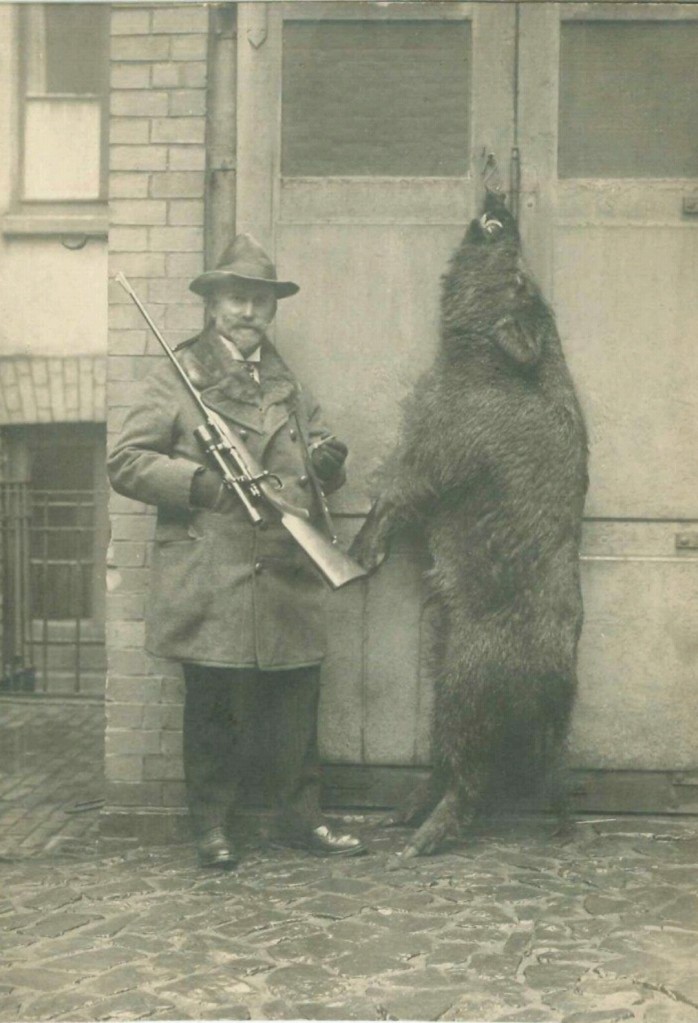
For some years there have been valid calibers, such as the .404 Jeffery, but at high costs, far from the availability of many settlers and breeders. The .375H & H was only partially the answer to that request. This cartridge was chambered only in expensive weapons: beautiful rifles, with heavy magnum actions and very very long barrels. Unfortunately the real problem continued to be bullets. Could sound Strange to today’s hunters, who can choose Solid and Bonded bullets able to guarantee incredible penetration and energy release even with normal calibers. Soft point ogives of the time were indeed fragile for typical speeds of the monstrous .375. Despite being heavy, they struggled to guarantee satisfactory performance, especially at short distance. Full jacketed ogives, on the other hand, tended inexorably to crush and twist, producing inconstant kills. It was certainly the best one could wish for, but there was a lot of room for improvement. Hunters and ranchers from German and French colonies had gleefully noticed how efficient the milder 9.3 × 62 was. Less exasperated speeds generated less stress on ogives which were so able to penetrate and release enough energy to invalidate the prey, creating a permanent cavity that quickly led to bleeding. Full jacketed bullets, thanks to high weight and optimally balanced sectional density, guaranteed good penetration with manageable recoil, all offered in a short action, easy to reload even under stress, with perfect spent cartridge extraction.
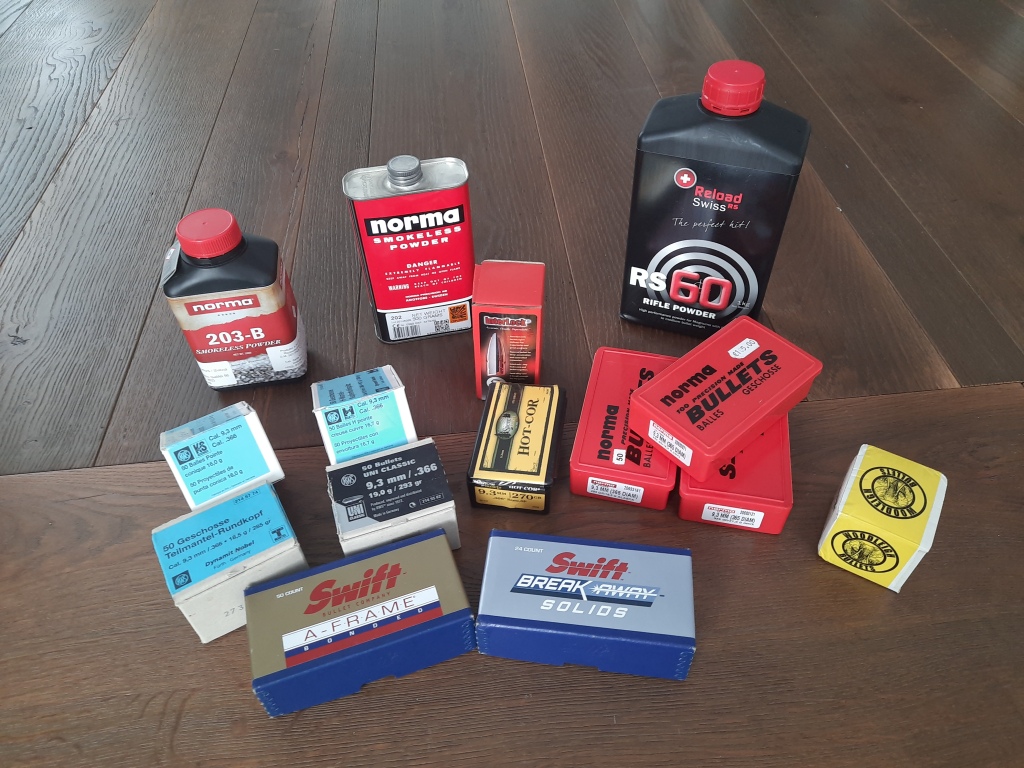
Chemistry and metallurgy, as we know, have been German industry prerogative for centuries. Otto Bock’s good caliber soon gained some fame, and was certainly an inspiration for Brenneke. He designed a new cartridge, starting from zero. Convinced by 9,3mm bore goodness, he designed the case from scratch. Roomy, pot-bellied, with graceful shoulder angle and a neck adequate to easily accommodate a long heavy bullet, with thick resistant walls able to withstand 4400 bar pressure without problems. 64mm long, like all Brenneke’s creatures, it fits perfectly into a standard K98 magazine. The 98 action is perfectly capable of handling this cartridge, chambering, firing, ejecting the spent case. Once again, the design of a new revolutionary ballistic system takes into account the German standard agreement on weapons , exploiting available resources to contain costs, optimize industrial production and allow existing arms conversion at sustainable prices. While the British industry designed weapons intended for wealthy owners and haughty nobles (often forced to resort to Mauser brothers work), brilliant Germans exploited Mauser’s mechanics in every way, bringing it to flexibility and reliability limits , succeeding in the incredible mission of projecting dozens of different calibers all suitable for the same proven Action.
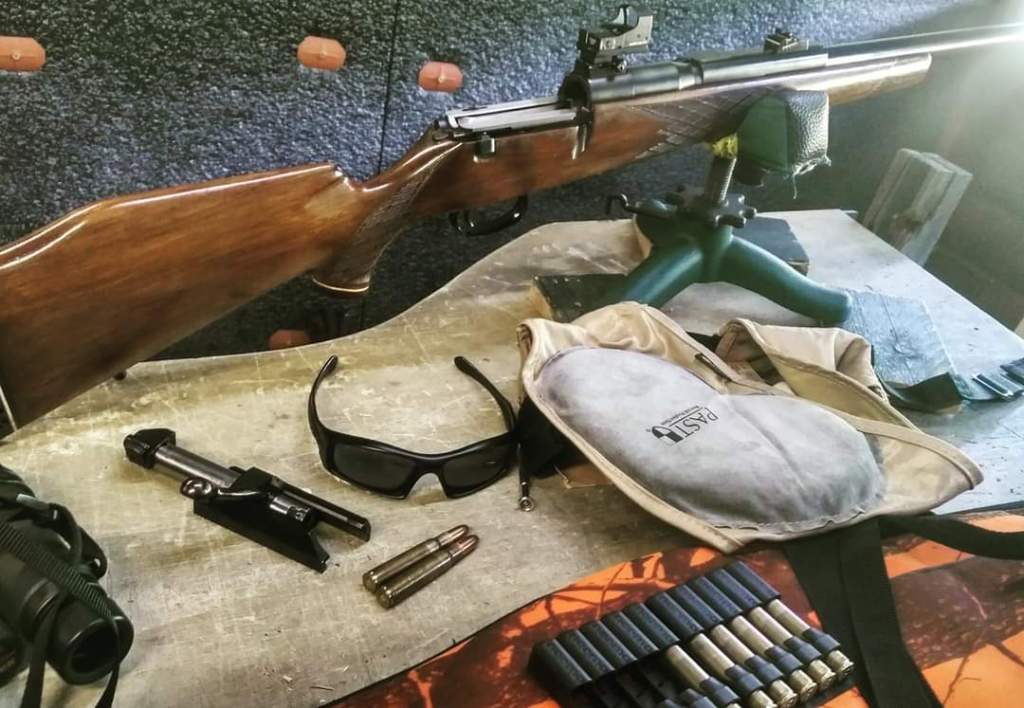
9.3 × 64 is precisely the entire production’s of the time spearhead. Able to reach 6000 joules, it was usually chambered in heavy, well-built guns, with 65 cm barrels, designed to ensure powder’s perfect combustion. It was 1927, the European hunters welcomed this remarkable creature, destined to conquer the African continent. Confess… it seems an outstanding achievement, exuding genius from every pore. But we’re only half done. Brenneke, as always, pushed the limit higher. In addition to being a brilliant gun and caliber inventor, he was the most futuristic bullet designer of the time. Some of his intuitions were the design basis from which many others started. His creatures, over a century later, still shine on weapon’s firmament.
Brenneke realized that creating a powerful, accurate and reliable cartridge wasn’t enough. The practice had already shown that having a lot of energy was only part of the solution: this energy had to be conveyed, and dispersed in the correct way. It was necessary to conceive and create an ogive that could assure penetration, energy transfers and precision, superbly able to manage high speeds and producing terminal effects never seen before. With these precise ideas, he gave birth to the incredible TUG, Torpedo Universal Geschosse acrony an engineering, metallurgy and ballistic triumph. This bullet still is the beating heart of this fine caliber, since it has been the only one offered seamlessly by the industry for an entire century.
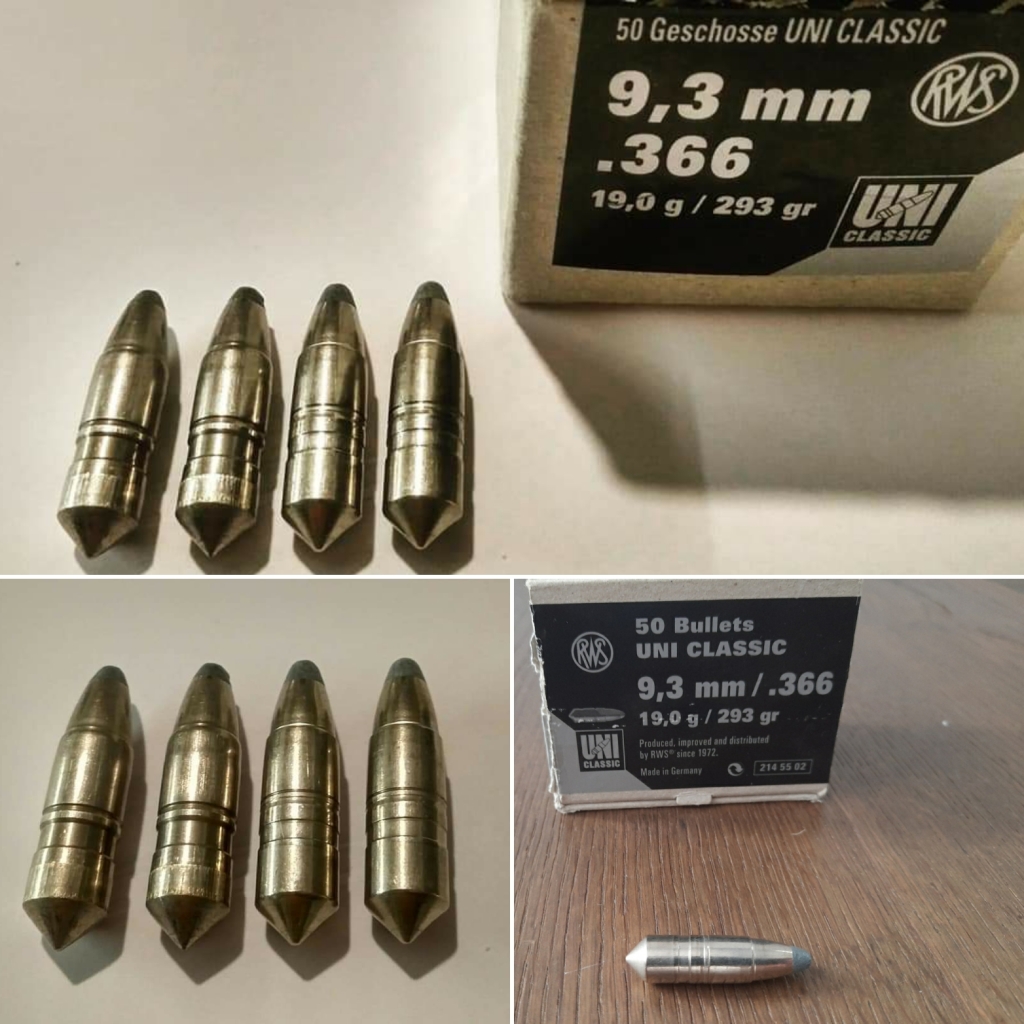
Brenneke and RWS basically stopped developing new ammunition for decades, simply because it was difficult to design anything better or more effective. Both RWS and Brenneke loads guarantee incredible accuracy. It is more than simple to obtain bench rest grouping at 100 meters, mounting a low magnification scope. Weighting 293 grains (19 grams) with decidedly high for the caliber ballistic coefficient , .465, the old glorious TUG boasts an exciting external ballistics, an easily compensable drop up to 400 meters, remarkable energy retention and cross wind insensitivity. The projectile structure, a soft and frangible front core and an hard rear one, allows a wide range of speeds quiet management : at typical 9,3×64 operating regimes, anterior core explose upon impact, seeding high energy secondary bullets with indecent damaging power. At milder speeds, the front core tends to deform, squeeze, and even separate from the rear, creating sometime two permanent cavities and a net egress hole. As always with German ogives, a sharp edge guarantees clear entrance hole punching, and the usual reassuring fur shaving, sometimes creating two permanent cavities and a net egress hole.
Impacts on heavy bones can push the bullet to the limit especially at close distance, but generally high mass and dispersed energy produce high shock anchoring the prey to the ground for an easy following shot. It’s certainly a bullet intended for large prey, but it also performs well on light framed games, and even without any deformation, killing will always be immediate with extreme meat respect.
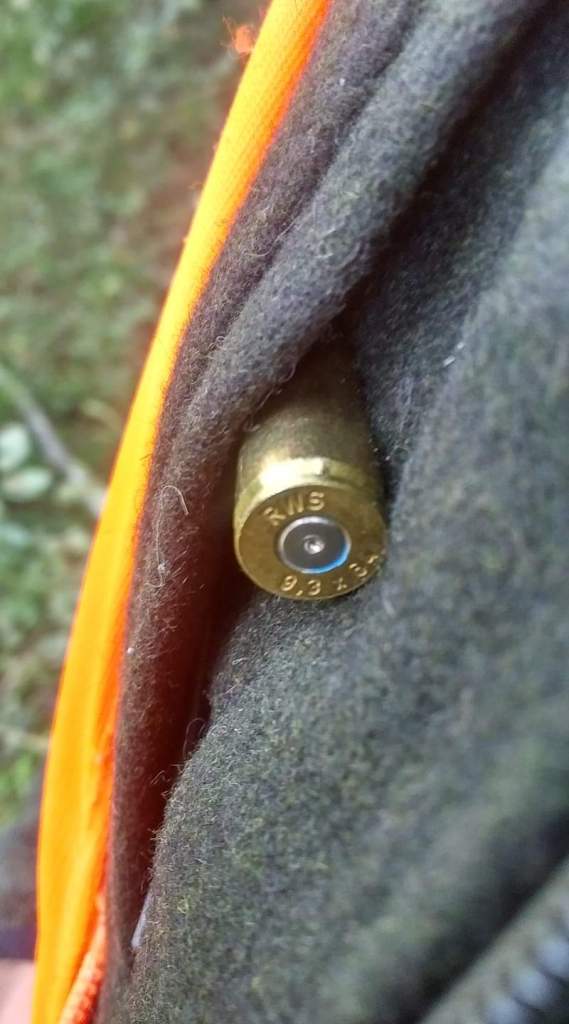
Without any doubt, TUG was a revolutionary ogive, certainly not intended for frontal shots on elephants and buffaloes. Although many have used it on Buffalos with decent results, it is too fragile and unreliable for today standards. Anyway, for everything lighter than these giants, just a few bullets are more effective. In over a century of service, chambered in the three 9,3mm calibers, it is certainly the bullet that has killed more heavy game in the world. A terrible old lady you can give maximum respect. Among with heavy 286-grain Vollmantel, it quickly built an unassailable reputation across the black continent, making the 9.3 × 64 one of the most reliable calibers ever. Rarely in history, a bullet and a cartridge have shared theyr destiny without separating. Well, this is a special story, unique in the world.
Theoretically, with today’s powders, it would be possible to squeeze several meters second, pushing the old TUG even more. But what’s the point? when one is close to perfection, trying further can just produce disappointments.
Unfortunately, up to now, only Voere produces a rifle chambering 9,3×64, based on the proven Mauser action. None of the European companies has in production weapons in our caliber, so probably it will be doomed to an undeserved decline in a few years. If you are lucky enough, you could find excellent rifles, with half a century of life on the shoulders, at very reasonable prices. It is not frequent or easy, but from time to time in armories selling private collections, it happens to find an unique piece .
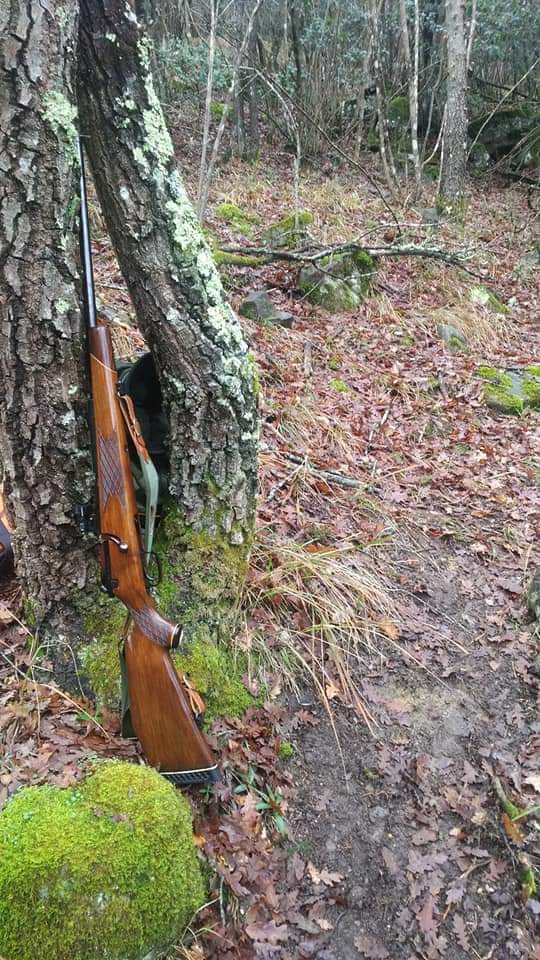
It happened to me a few years ago. Almost fortunately I came across a Mauser Europa 66 Africa, equipped with shotgun type trigger and intuitive express sights. A careful weapon’s inspection didn’t reveal defects or damages. I discovered that it had been used on two safaris in the 70’s and then nothing more, it layed for almost 40 years in a blind. Wood was barely marked, iron simply excellent. I just had to adjust trigger weight, carefully clean bolt, barrel and trigger group. Then my gunsmith installed EAW pivot bases. Weapon’s weight with scope mounted is quite high, but it’s not really a defect seen the vigorous recoil with heavy bullets. The generous and well-designed stock discharges well recoil, detection is not prohibitive unless using peppery loads with heavy bullets. The scope I mounted is a beautiful Z6i EE, with long eye relief, designed for large calibers. Its 12 cm eye relief allows immediate target acquisition even at close range. It is certainly not the best drive hunt weapon (although I have used several times, carrying a tripod and managing to hit running animals at long range) but if you want hunt large games, this combination it’s incredibly deadly. The question everyone is now asking is banal and basically obvious: why the hell you should own a weapon like that? Quick and effective answer is: why not? because it exists and is beautiful. Correct answer, only for deserving ones, is that with some work, a rifle like that allows unmatched flexibility. Working on reduced charges, it will be possible to match milder 9.3 × 62 or 9.3x74R performance. Choosing the right powder it is possible to obtain an “European load”, not punitive for meat nor for the hunter. And more, if are so smart to find the right bullet, you can hunt wild boar, deer, fallow deer, without exceedent power but using an exceptional ballistic system on extremely well made weapons.
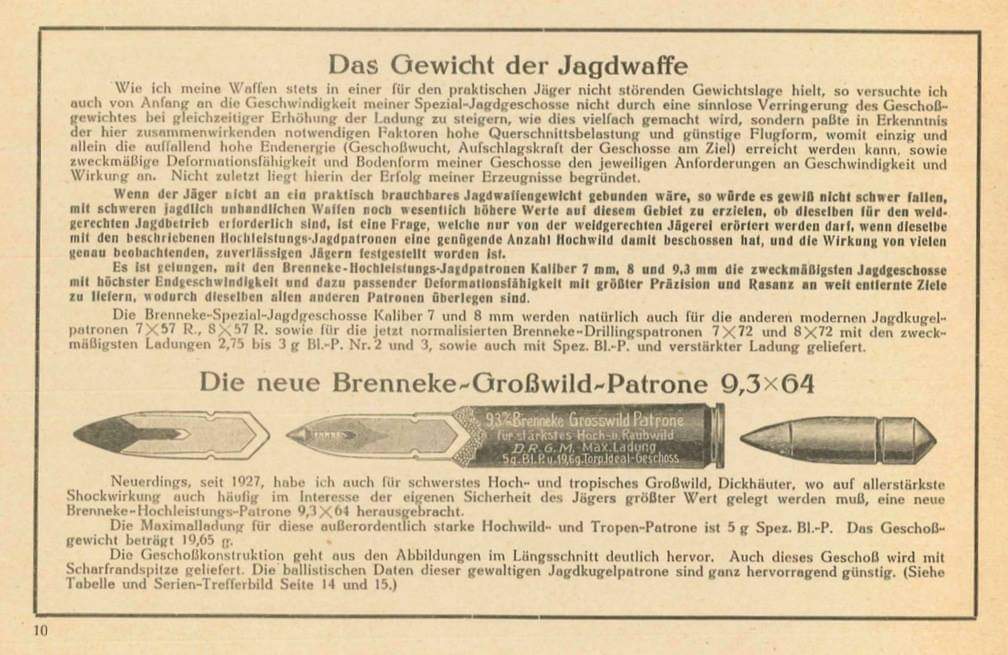
Anyway, if you dream about an African Safari, or an Hungarian digression for acromegalic deer, you can fully exploit the most beautiful European cartridge’s potential. It’s easy to understand how such a futuristic caliber is today a potential basis for modern calibers development. Just think that using lead free bullets, it’s easy to obtain excellent ammunition with smooth recoil, and incredible effectiveness on light and medium games. With overwhelming foresight and intelligence, RWS proposes the 185-grain Evolution Green ammunition, alongside the eternal 293-grain TUG, true Big Game Hunting queen. This light leadfree ogive has shocking ballistic qualities. With close to 970 ms muzzle velocity its trajectory is almost equal to the 8x68S one. Ogive structure makes it a Jolly for medium and light game. The front part of the bullet is fragile , prone to fragment upon impact, generating many secondary bullets. The rear part, although light, penetrates deeply with well marked egress hole. Zeroing at 200 meters it’s possible to kill medium-sized game up to 300 meters without overcompensation. A wave of modernity revitalizing this old caliber, now even competitive with some modern american calibers. Forget long range! This cartridge was born as a solver at short and medium range, stronger than its milder cousin 9.3 × 62. .366 bullets, with some rare exceptions, are exclusively designed to hit hard, destroy bones and muscles, brutally dump energy and put the large ungulate on the ground without any chance. Having flat enough trajectory, African-sized games up to 400 meters are easily achieveble. When vital area is as large as a Van tailgat , the range of use of a good 9.3 × 64 rifle is well beyond 500 meters, taking into account game’s beahaviour and vitality. Modern monometal bullets is a novelty capable of revitalizing this caliber creating unthinkable possibilities. At the same time, Solid bullets evolution has opened up new and extremely interesting scenarios. Unfortunately for this and other European calibers, the greatest limit to diffusion is represented by political reasons. War defeat, in 1945, negatively affected every aspect of German industrial production. The British, in all their colonies, set shameful limits. The minimum caliber allowed for Big Five is almost everywhere .375. Paradoxically, you could use a 45/70, but not the powerfull 9.3 × 64. Anyone who chews something about weapons and ballistics can understand that talking about cartridge lethality we should consider several factors, such as muzzle speed, bullet’s weight, muzzle energy and also 100 and 200 meters energy. Parameters that let us understand if a cartridge is effective on dangerous game at medium engagement range.
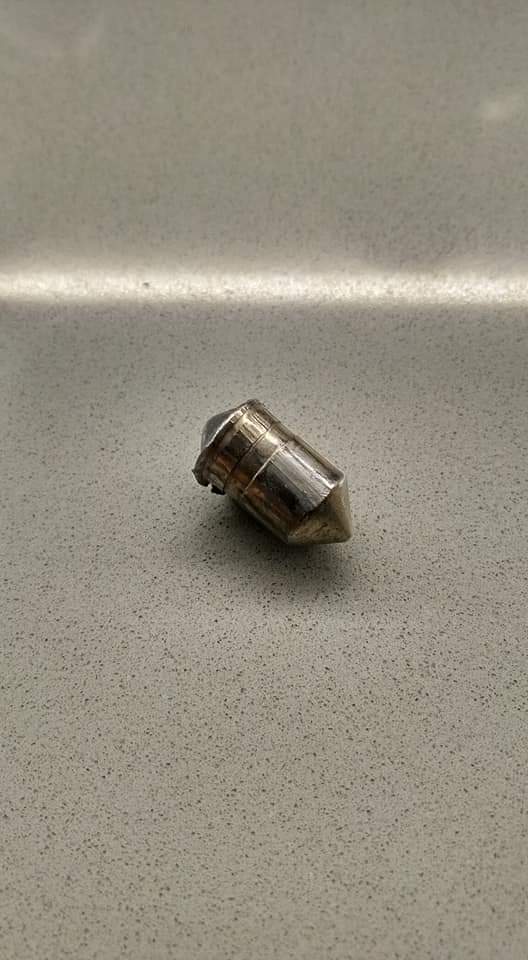
Although the desire to erase defeated enemy’s traces is understandable, after 80 years it seems at least anachronistic and almost ridiculous to believe that a .375 bullet is enough to shoot down an Elephant or a Cape Buffalo, while a .366 doesn’t, while having superimposable energies. Nowadays only a few African countries have lifted the veil on this subject, wisely requiring minimal muzzle energy to allow it for dangerous species. Frankly Speaking , neither the good 9.3 × 64 nor the .375H & H are the best choice to annoy dangerous beasts, and they certainly are not able to stop a charge.
From a purely ballistic point of view, our 9.3×64 has some advantages over the .375 H&H. As already mentioned, it can be chambered on a standard 98 action and it works well with 65cm barrels, it is an efficient cartridge that can count on an impressive sort of ogives: it is virtually possible to hunt every game from roe deer to elephant shifting from light and very fast lead-free bullets, up to heavier ones, with ultra-resistant structure, high ballistic coefficient and high sectional density. The .375 ogives of similar weight always have lower sectional density, lower ballistic coefficient, but the English thoroughbred can spit 350 grain stout bullets, while the Teutonic counterpart stops at 325. This competition is going on from a century, actually without winner. What really puts the .375 on the top podium step is its widespread diffusion in every remote place where it is possible to hunt huge beasts. Excluding former German colonies, I believe it’s very hard to find 9.3 × 64 Brenneke ammunition outside Europe, unless you specifically order them. This aspect is incredibly limiting, because in case you lost your ammunition luggage, you would find with an useless weapon.
Although, as we have seen, while a few hunters own and use this splendid ballistic system, it is still possible to count on numerous commercial ammunitions. RWS essentially offers two cartridges: the timeless Uni Classic (identical to the TUG with same performance) and the ultra-modern Evo Green, with embarrassing external ballistics. RWS ammunitions allow the hunter to undermine all European and North American mammals without worries, and practically all African games , taking, Elephant, Buffalo and Rhinoceros out of the mix. Certainly lion and leopard are within TUG reach, although there are far better medicines for extremely dangerous felines.
Brenneke, for theyr part, did not stand watching: alongside the eternal TUG, there are the new TOG, Torpedo Optimal Geschosse, an hard bonded bullet , and the latest born TUG Nature, double core, lead-free 220 grains ogive that promises to be an exciting novelty. TOG is the most powerfull ammunition. It boasts 860 ms at muzzle, reaching 5900 joules. With an ultra flat trajectory it is certainly able to get the job done on large game with extreme vitality. The rather modest weight, 247 grains, slightly limits its sphere of use. A similar 19 grams bullet would probably have been the ultimate tool for Big Game Hunting. At the same time it’s also true that it probably occupy an interesting segment: there are no 16 gram Bonded bullets among commercial loads, and it is plausible that Brenneke wanted to fill this gap with a well made effective bullet. The brand new TUG Nature, released this year, is very similar to the Tug, built with innovative materials. Design follows the ultra-proven TUG one, with decidedly light weight, 220 grains, 890 ms for almost 5700 joules at the muzzle, flat trajectory and certainly well manageable recoil ( unfortunately at the moment I was unable to test them). I would never use them in a drive hunt due to its frangible structure, but for stalking medium and small game I think TUG nature could be a good choice.
Finally, the eternal TUG we have already discussed about. It remains to say that it’s one of the best 9.3mm ogive, with one of the higher ballistic coefficient, and proven effectiveness after a century of service. It tends to blows in close shots, and usually half mass loss limits its penetration. I find that, as usual with older bullets, best performance is between 80 and 150 meters. At this distance the Brenneke star shines brighter than ever: Impact on any large mammal produces spectacular killing, with usually limited meat damage. Energy dump is strong, so that even poor placement invariably produces quick kills.
Sologne proposes a Nosler Partition bullet load, but I have never tried it.

Anyone who intends to walk the splendid path traced by Wilhelm Brenneke, should necessarily handload his cartridges. Only in this way you can explore infinite possibilities offered by this splendid caliber. Cases can be easily found, manufactured by RWS and Brenneke, for a decent amount. However this is not a caliber for long shooting sessions at the range: it is able to demount your shoulder. Once you have found the right load and you develope the right feeling with your rifle, you can count on something that has no equal. Anyway, This aspect is not strictly negative. Generally strong recoil guns, age very well. Mine, for example, are 50-old years old but I have shot a lot more than the previous owners. If recipes are not exasperated, you can reuse shells several times. Unlike the closest cousins, the powerful 8x68S and 7 × 66 Vom Hofe, cases preparation does not require painstaking attention. Thanks to generous bullet dimension, once the case has been recalibrated in the full dies and trimmed to length, we can proceed. In my opinion recommended primers are Magnum type, being the case roomy and generally used powders with medium burning rate. As usual, I find RWS primers exceptional.
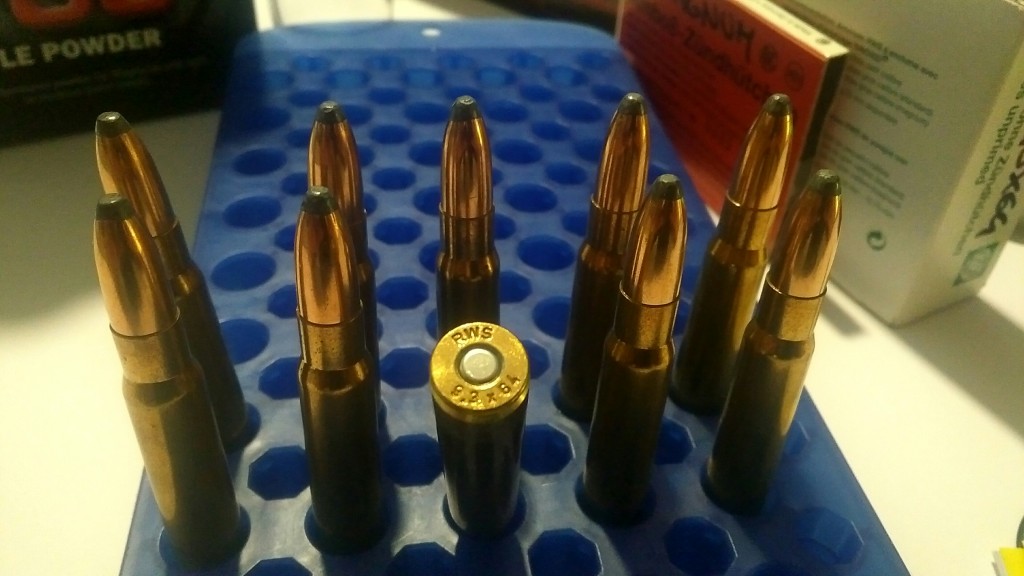
Best Powders are practically all those with intermediate to slow burning rate. All 9.3mm calibers are generally generou, digesting everything and producing good or excellent groups, with usual monotonous efficiency. I developed recipes with practically all the powders I have had over the years, from the N140 to the N160, passing through 202, 203B, 204, and ending up with the outsider, RS60. This powder has proven to be unbeatable, producing very high speeds while maintaining low pressures, for definitely safe charges even at equatorial temperatures. While collecting some headaches, experimentation on these recipes has continued in recent years.
Follow us also on Instagram:
https://instagram.com/mauser_italy?igshid=14q6iwpm5b3gy
Let’s move on to analyze ogives, which as usual are handloading heart.
• ORYX STANDARD 232 grains.
Too light but damn tough.
When I started reloading the 9.3×64 I hadn’t considered these bullets, but after some time, having seen how efficient they were in the 9.3×62, I had the curiosity to test them at high speed. As usual I wrote Norma asking suggestions; the answer arrived soon.

Lighter Oryx bullet was designed to work at 800ms; being dedicated to close shots on stout animals, high speeds could push the bullet to over expand. By now curiosity was digging and only field experimentation could had answer. Having found the right recipe, with not exasperated speed 850 meters per second, so it just remained to hunt the right game. Unfortunately we have no antelope, zebra or Eland in Tuscany, so the unlucky tester was an unwitting boar covered by winter mud. Hit while trotting off the beat, it collapsed into a ditch without letting out a groan, the short tail swirling in the air as often happens. Fortunately I was able to retrieve the bullet, which had penetrated the neck and reached the abdomen. The Oryx’s wreck was the size of a large ancient coin, it had totally overexpanded, dumping all the energy and causing an indescribable internal wound: Impressive damage fortunately limited to internal organs. Unfortunately I lost the recovered bullet and pics I had taken, but I can assure you that the tenacious Swedish bonded Oryx had performed a small miracle losing only a part of its original weight. My experiment ended immediately. It was clear that this bullet could not withstand similar stress, Anyway I think it’s one of the best bullets out there considering how it passed such a test; Really remarkable.
• RWS KS 247 grains.
Accurate and deadly.
Like in many other calibers, Keghelspitz shines in this hypertrophied 9.3mm too. I will never tire of saying : KS cloak is a triumph of metallurgical engineering. It has perfect hardness to be stabilized by almost every barrel twist, while on games it always reveal to be balanced: it loses a percentage of mass but hardly falls apart or separates.
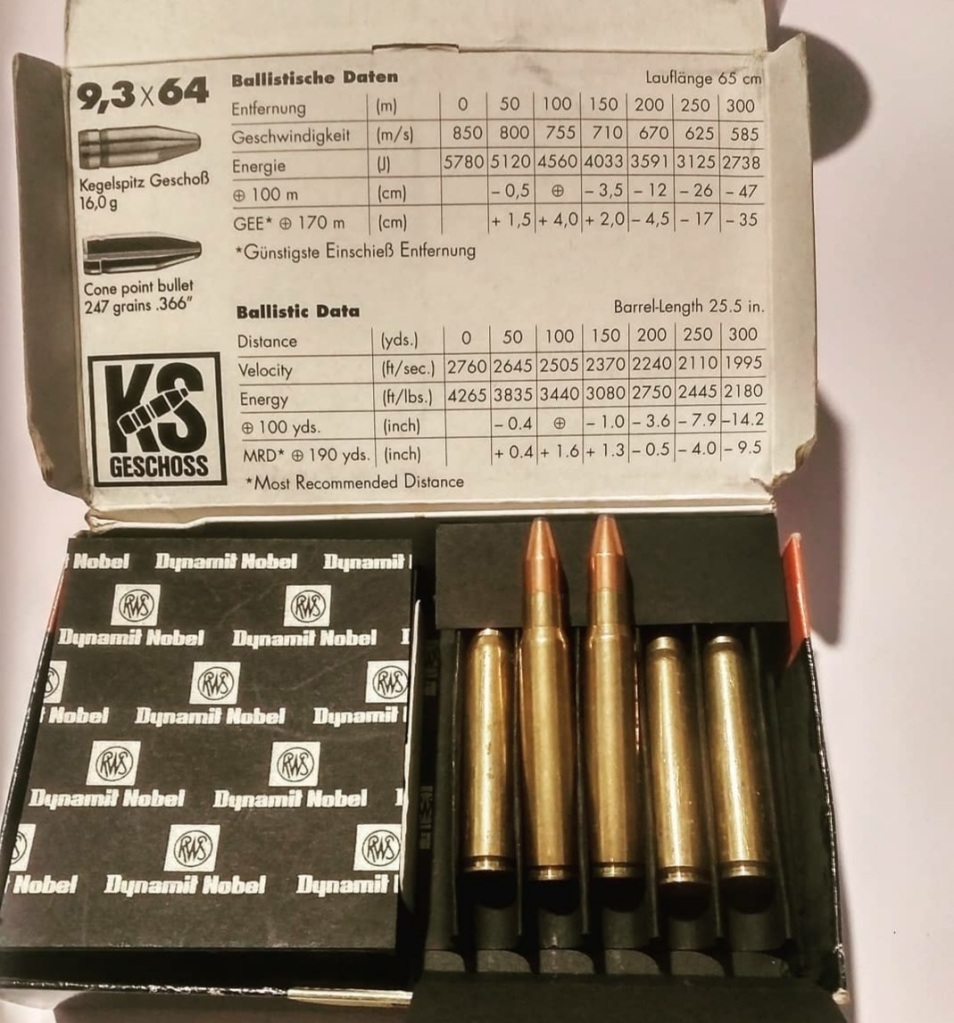
Only in frontal shots or if impatcing heavy bones I observed embarrassing separation between core and Mantel, but in 99% shots it’s just surprising. It’s perfect for medium and light game, accurate beyond all expectations, ideal for Blatt shots. In large animals, up to Kapital Red deer, it can be used If caring shot placement. Neck shots and surely chest shots must be first choice to enhance stopping power and to preserve meat. The main Achilles’ heel is the relative fragility which requires some care, anyway for long shots it remains one of the best choices. For decades RWS has proposed 247 grain KS ammunition with 850ms at the muzzle. I reproduced the same performance, with manageable recoil that allow to observe game’s reaction to shot, if ever there would be. Cases arn’t absolutely marked by overpressure, feeding is fluid without minimal jamming. Theoretically, using the RS60 it’s possible to achieve higher speed, but it would be really disruptive seen bullet’s structure. Once again, this is not a long range caliber, even if in some ways it could wink at long distance. Brenneke’s excellent Tog can be considered KS’ revised and corrected version, adapted to the 9.3×64 working conditions.
However, Kegelspitz bullet remains a good choice, producing incredible knockdowns, even with poor placements in dirty shots.
• H-MANTEL 258 Grains .
Wunderbar!
The best bullet ever tested in this brilliant caliber. For several seasons I used H Mantel on 9.3x74R and 9.3×62.
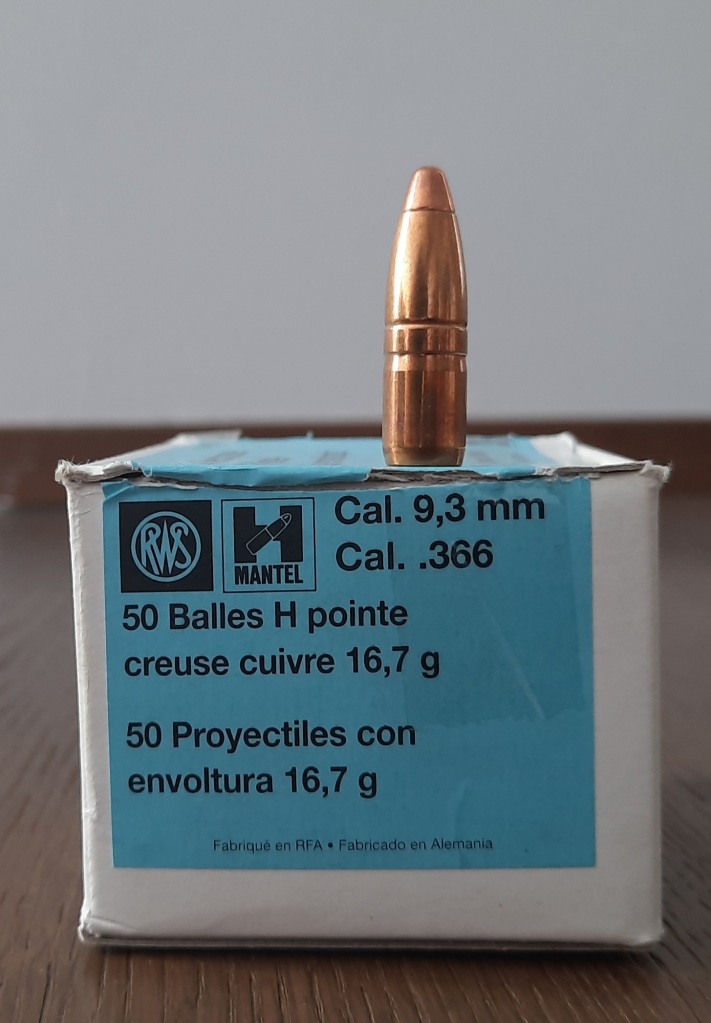
Its performance was never exciting probably because, like other standard calibers, energies produced were not enough to make this bullet shine. Having observed how dramatically terminal effegts changed shifting from the mild 8x57JS to the beefy 8x68S, I had the precise feeling that if loaded in the 9.3 × 64, the old H Mantel could astound. Results obtained were incredible. In truth, it is not my bag: RWS manual shows a well-pushed dose, which would achieve 850 ms, with impressive energy and respectable flat trajectory. Using the splendid RS60 it was easy to reach these speeds, obtaining bench rest accuracy at 100 meters with energy value dancing around 6000 joules. Venerable H Mantel has reached the ninth generation, virtually unchanged.
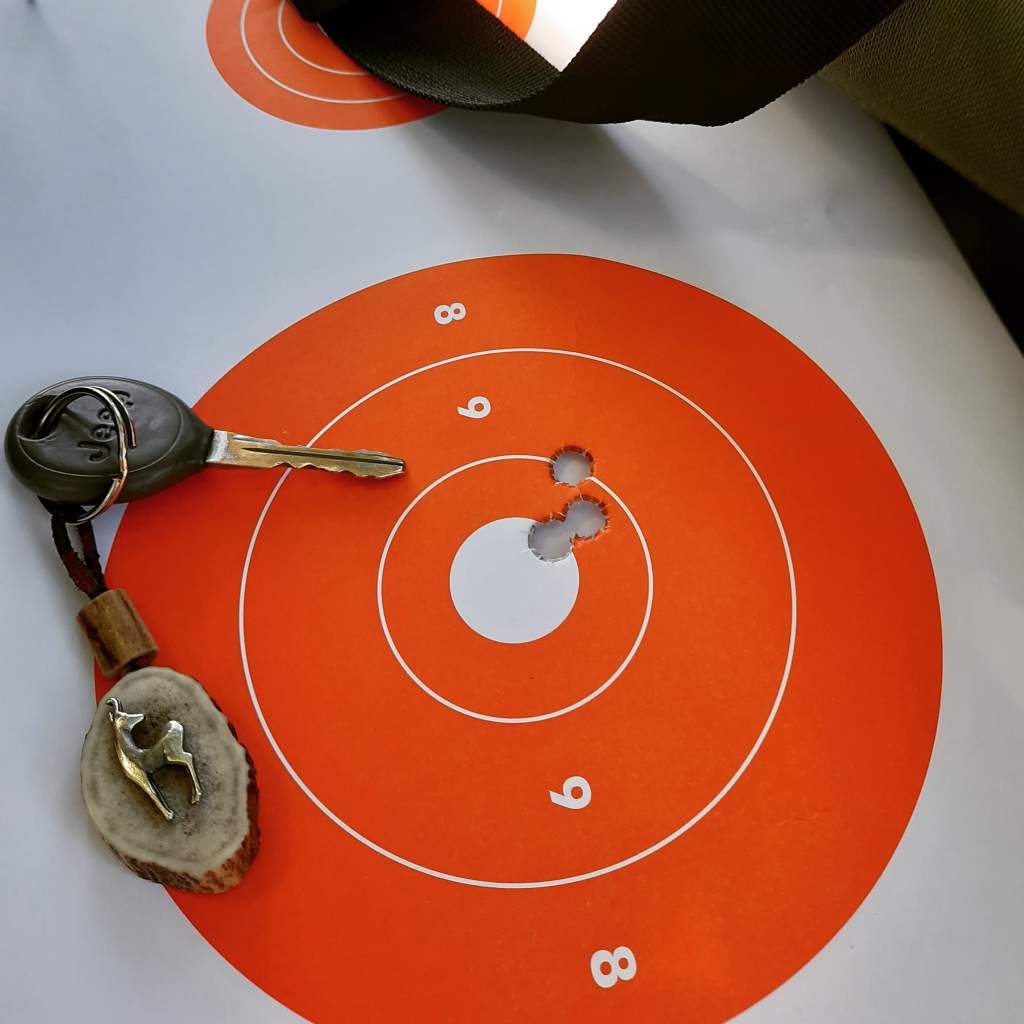
Hollow front core, surmounted by a rounded dome. Solid rear core to guarantee penetration and exit hole. On huge wild games, we’ll generally witness variable reactions in relation to shot placement. If hitted on the shoulder or in the thoracic area, we will see lightning-fast killing on large and medium size games.
When targeting lower ribcage or abdomen, game generally remain anchored to the ground or assume a a strange drunk behavior, collapsing in few moments. Also in this case a following shot is not always necessary, unless the game in question is dangerous. Unfortunately for fans, H Mantel is no longer produced in 9.3mm. Fortunately RWS has put the brand new Speed tip into production, same design but better ballistic coefficient. We’ll try it soon.ì
SPEER HOTCORE 270 Grains.
Honest.
This inexpensive, singularly weighting bullet, stands between light and heavyweights. It has a good ballistic coefficient and shots up to 250 meters are not a problem.
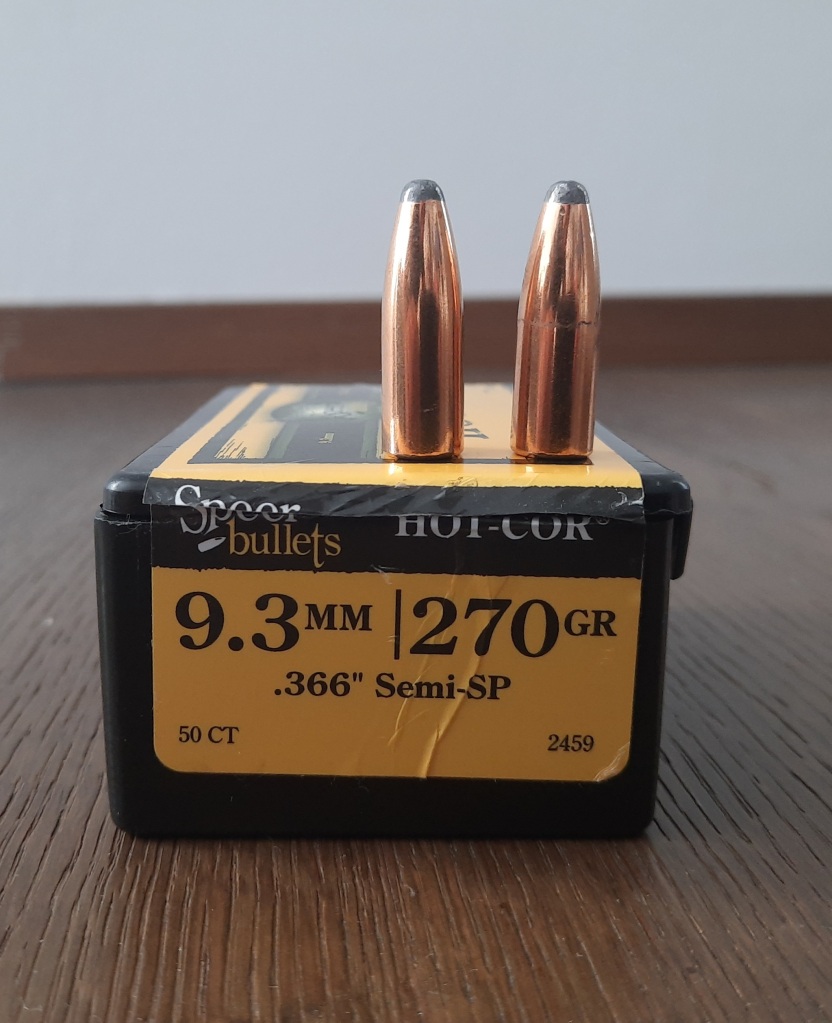
Despite being a bonded bullet, welding between core and mantle is not tenacious, so that even at the milder 9.3×62 speeds it tends to loose weight after violent impact at close distance. When Used in 9.3 × 64 it can work well, with correct expectations. Loss of more than half weight is acceptable when used on large game, showing how lethal secondary projectiles can be. Weight and structure ensure optimal penetration and energy release. Having to hunt huge deer or African antelope, I would certainly use other ogives, but in my experience, a Blatt shot, even from relatively short distances, would be damn lethal with the Speer.
A great bullet for the price.
RWS TEILMANTEL 286 Grains.
Timeless classic.
This ogive comes straight from the golden age, unchanged and still splendidly effective.
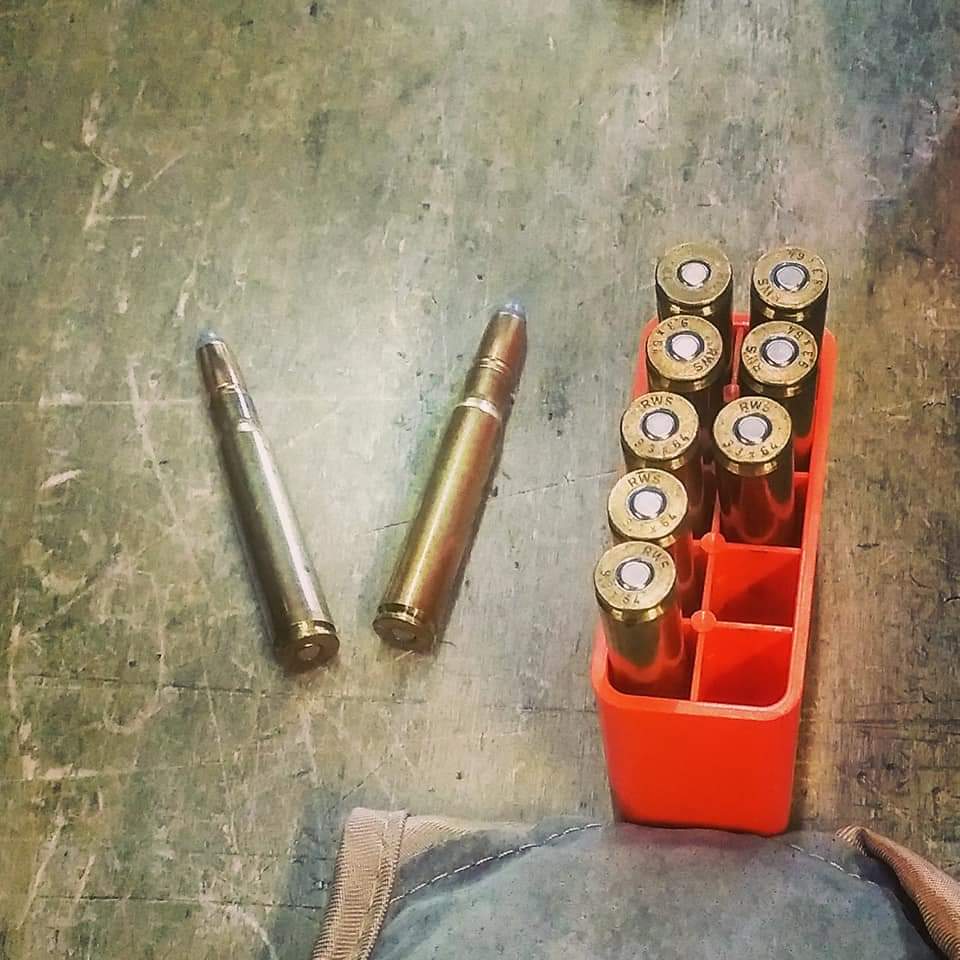
Let’s say what we’re all thinking right away. Not the best bullet for such a powerful caliber. True. Although RWS for a couple of decades produced cartridges with the old teilmantel pushed to 800 ms , surely today we are plenty of better bullet, suited to manage energies involved with these speeds. I just can’t figure what effect 18.5 grams of soft lead could had on game, flying at V2 speed. What I have been able to observe is the extreme precision and consistency that this simple ogive can produce. I worked out a recipe with the old N160, nothing exasperated. It reproduces 9,3×62 performance with an incredible accuracy .
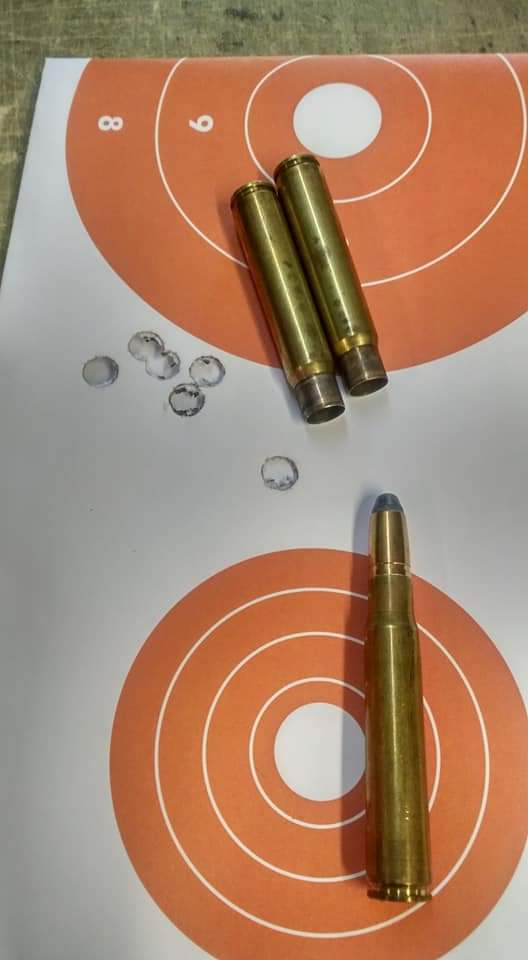
With this load I have faced several wild boar hunts, with great satisfaction. The only advantage over 9.3 × 62 is that rifle’s workmansh and ergonomy are considerably better, recoil more modest and accuracy absolutely remarkable.
NORMA ALASKA 286 Grains.
Just fantastic.
I used these ultra classic bullets for a couple of seasons on my express, with great satisfaction. At the comfortable 9,3x74R speeds it was able to perform lightning-fast knockdown; respectful on light games and maximally lethal on large ones, it has always been constant and accurate.
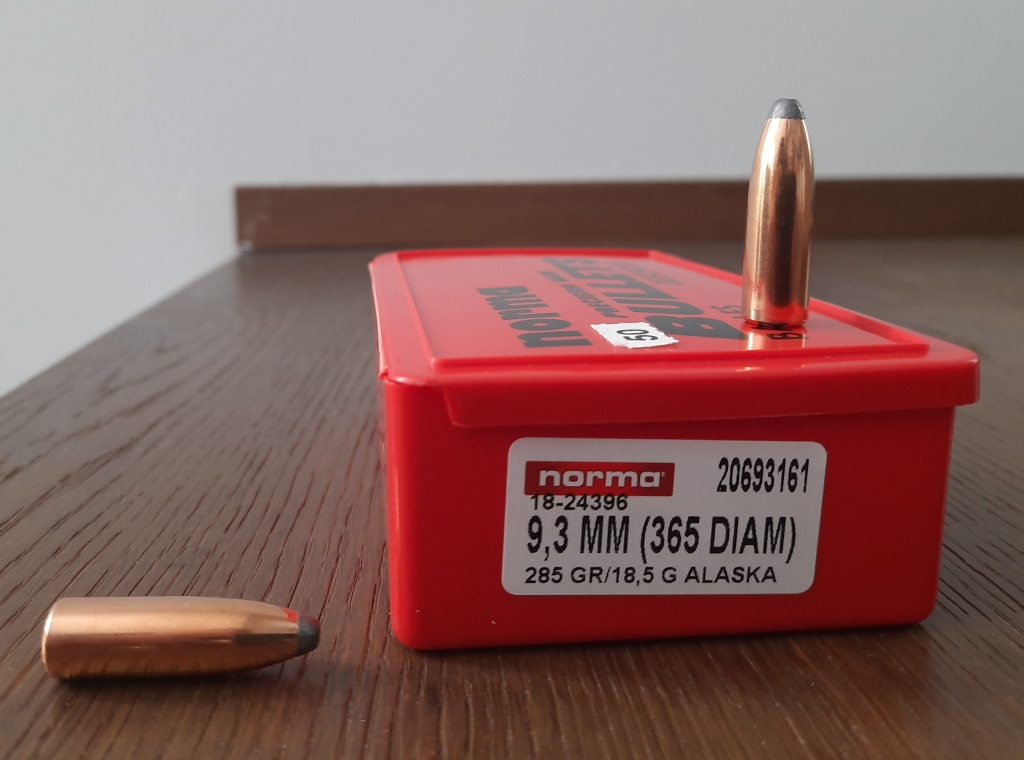
Definitely harder than RWS Teilmantel, it guarantees good expansion and always high weight retention. I never managed to recovery bullet’s wreck, as they always produced egress holes even on frontal shots. Trying them on the good 9.3 × 64 was a curiosity to satisfy. I started with fairly soft charges, ending up with a decidedly peppered one, always using the excellent RS60, that gave me great satisfactions.
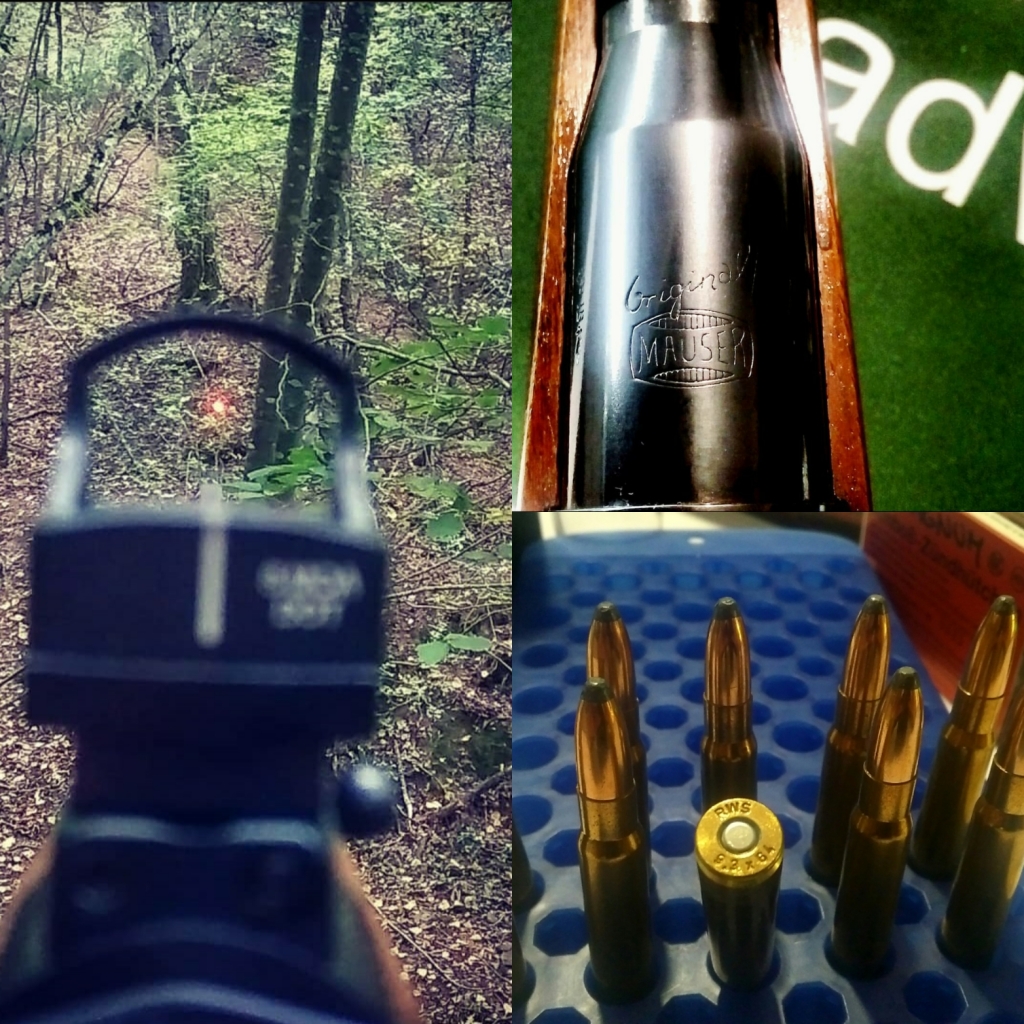
It all started chatting with a friend who hunts in the alps. He told me how, after Vaja hurricane, huge forest portions had become pasture land, how deer population had tripled with huge males starting to assume Hungarian size. Anyway, these deers were shrewd alpine animals, used to fleeing man and to fear shooting. My friend’s problem was to carry a train of energy up to 200-300 meters with flat trajectory. I suggested using an 8x68S, but he insisted that he would rather prefer a bigger bore, because losing a huge deer at sunset and finding it devoured by wolves the day after would definitely ruin his sleep for ever. Those long heavy bullets were a good insurance to him. I suggested trying the monstrous Brenneke. He was immediately interested. I worked out a good recipe, the peppery one I mentioned above. At range accuracy was so good that i wrote an article, later published on Norma website.
My friend fell in love with my idea, and ended up having a carbine built. When the roaring season was underway, he called me one afternoon telling a short fine story, amazed by 9,3×64 brutal effectiveness. Although its traditional construction, Alaska is certainly one of the best 9.3mm bullets, capable of handling high speed. High weight and quality mantel guarantee good penetration and great energy release.
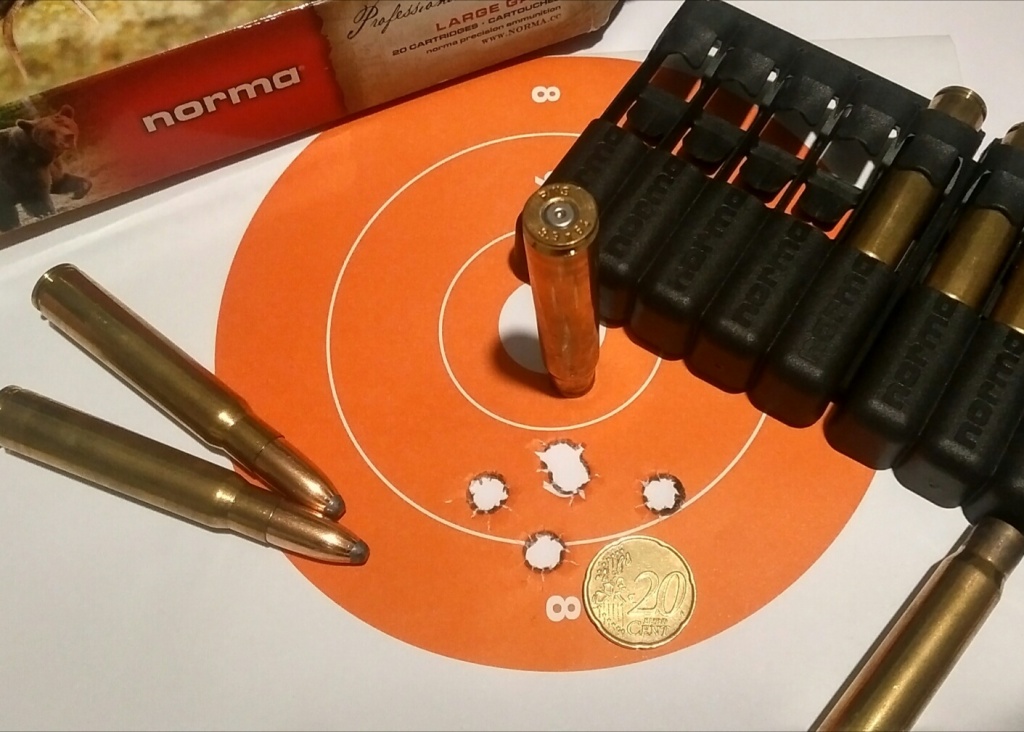
Spitted at 800 meters per second, it’s an excellent medicine for almost all soft-skinned games on earth. Considering how wide can be large game’s vital area, it’s intuitive that up to 300-400 meters this caliber/bullet combination is terribly deadly. Certainly not a modern ogive, surely not a meat saver, but a brutal insurance: you won’t have to chase wounded animals for kilometers, risking injuries in remote territories.
BRENNEKE TUG 293 Grains.
The Queen.
Where it all started, specifically created to brindle the 9.3×64 incredible power. We have extensively talked about it, so not much remains to say. If you ever have a doubt about which bullet employ for any non-dangerous soft skinned mammal, TUG will always be the answer. Now it’s dated, but continues to claim victims without interruption from a century. It deserves great trust.
SWIFT A-FRAME 300 Grains.
Superb.
Anyone who had hunting experience in Africa has heard of these reliable and hardy ogives.
This small American company has carved out an unassailable reputation among all hunters who love big game hunting. Its super tested structure makes it an excellent choice in any type of situation, especially for very large game. A Frame has two cores, both bonded. The anterior one is obviously softer, and tends to uniformly deform. The rear core is hard and able to achieve deep penetration, and if subjected to violent impacts, it is prone to deform without losing mass. Its performances are peculiar: typically large entry hole, which is frankly unique among bonded balls, wide frayed exit hole, always productive. In our caliber, the 286-grain A Frame bullet would perhaps have been more efficient, but since it cannot be found, I had to use the 300-grain one. Handloading was not difficult, since best cartridge length is indicated in several manuals, 84.2mm , and achieving good accuracy took only one trial. 300 grains bullet proved to be very constant at 50 and 100 meters.
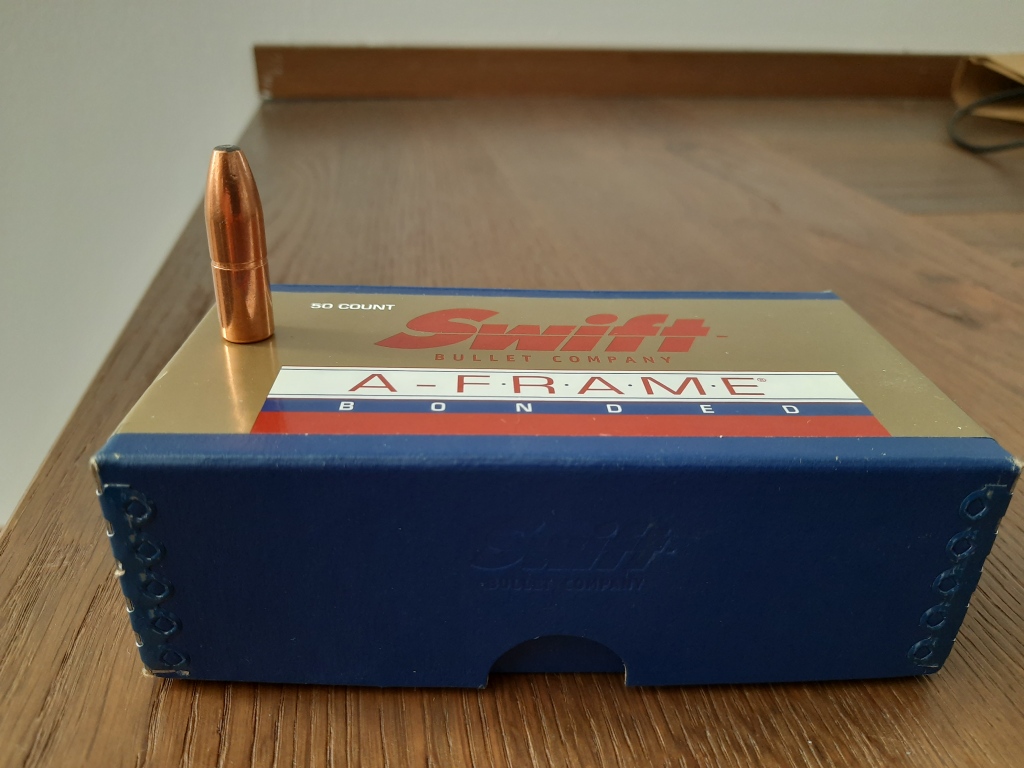
Teoretically it’s possible to get close to 6000 joules, keeping the pressure relatively low, using reliable RS60 powder. This aspect is fundamental if you want to develope loads intended for torrid countries: high temperatures inevitably tend to raise operating pressures. A good stable powder and a safe operating pressure, will allow a peaceful use in all conditions. 300-grain rounded shape assure smooth feeding avoiding any jamming: important factor if you are hunting dangerous games. As always pay maniacal attention to Free bore values on your weapon. Starting pressure is higher than normal soft points and other Bonded bullets, Being A Frame hard ogives. Strictly follow recommended doses to avoid dangerous overpressures. Unfortunately Swift company, pruducing high quality Big Game dedicated ammunition, doesn’t even have a 9.3 × 64 Brenneke cartridge on catalogue. Using handloaded cartridges in extreme environment like Africa, for dangerous game hunting is always a small gamble; some organizations require their customers to use commercial ammunition to avoid insurance trouble and possible prosecution. If ever Swift should put on production a fine 9,3×64 cartridge, it would be welcome, giving life to a thoroughbred horse that has few equals. Up to now I haven’t been able to fully test A Frame qualities. Covid has definitely spoiled my plans, my test will have to wait for better hunting periods and grounds. But it’s only postponed.
Norma Oryx 325 Grains.
Unstoppable Express train.
Great performer, the stout 325 grain Oryx. Long, heavy, frightening sectional density and substantial ballistic coefficient, it’s a bonded but soft bullet. It was designed to mushroom at typical 9.3 × 62 speed, but in any case very high mass promises exceptional penetration and enough residual weight to kill large soft-skinned Games. Energy transfer is always high, accuracy usually surprising.
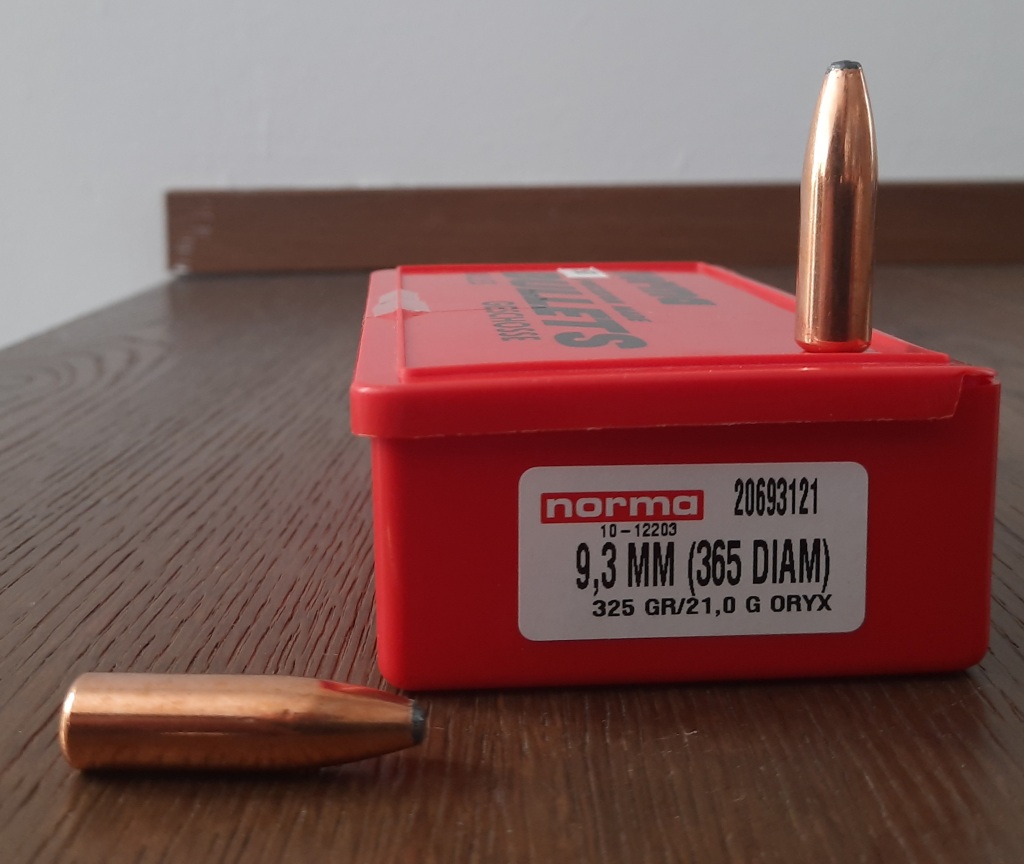
Like all .366 Norma ogives , it is slightly undercalibrated, ensuring good speed without overpressure risk, quite unique among bonded bullets. Recoil is strong, punitive for both the shooter and the Game. Detection is always remarkable, due to projectile mass, so sometimes it’s difficult to see game’s reaction, if there is any. Particular attention must be paid to correct cartridge length. Being very long it can create feeding problems, while shortening overall length can lead to dangerous pressures. Consider these factors if you decide to load it. As usual, a correct free bore check will be essential. I found both the N160 and the RS60 suitable. The first is precise but achieves significantly lower speed than the Swiss powder. Huge deer, antelope, bear, moose, and any other soft-skinned mammal are easy target for this excellent Oryx.
WOODLEIGH 320 Grains
Fantastic.
Woodleigh bullets have always been among the best in the world. Between Big Game Hunters, their reliability is indisputable. Being the chemical welding process inventors, they have gained a solid reputation from the beginning. There is no African hunter who hasn’t used their splendid bullets.Not a coincidence if Norma loaded their bullets for a long time (until the Oryx was marketed), and still continues to load on Dangerous Game Ammunition. Both 320-grain bullets can theoretically handle 9.3 × 64 energy and speed without embarrassment. Round Nose ones, however, often pose feeding problems. Right now, many 9,3×64 rifles have a lot of springs on their shoulders. Initially, Mauser first, weapons were built around a precise bullet, and the spearhead was TUG bullet of course. Round nose bullets with pot-bellied profile often get stuck. Having feeding troubles under stress is a terrific experience. On the contrary, when assembled with correct cartridge length Protected Point ogives are smoother and extremely accurate. These bullets are hard expanding, prone to mushroom only if impacting massive bones and muscle structures. Their mission is penetration: Designed to penetrate deeply dissipating just a part of energy to reach large games vitals, Protected Point have good ballistic coefficient, excellent sectional density, and usually good accuracy. If you ever decide to pick this caliber for a buffalo hunt, you have two choice within Bonded bullets: Protected Points and A-Frames. To fully test these beautiful ogives’ qualities, it would be necessary large African games. Right now, alas, we just can work on recipe and wait for better times. Years ago I set up a small batch of ammunition with 250-grain Soft point round Nose. Although I tried to limit cartridge length, I had a bad jam due to the peculiar bullet’s roundness.
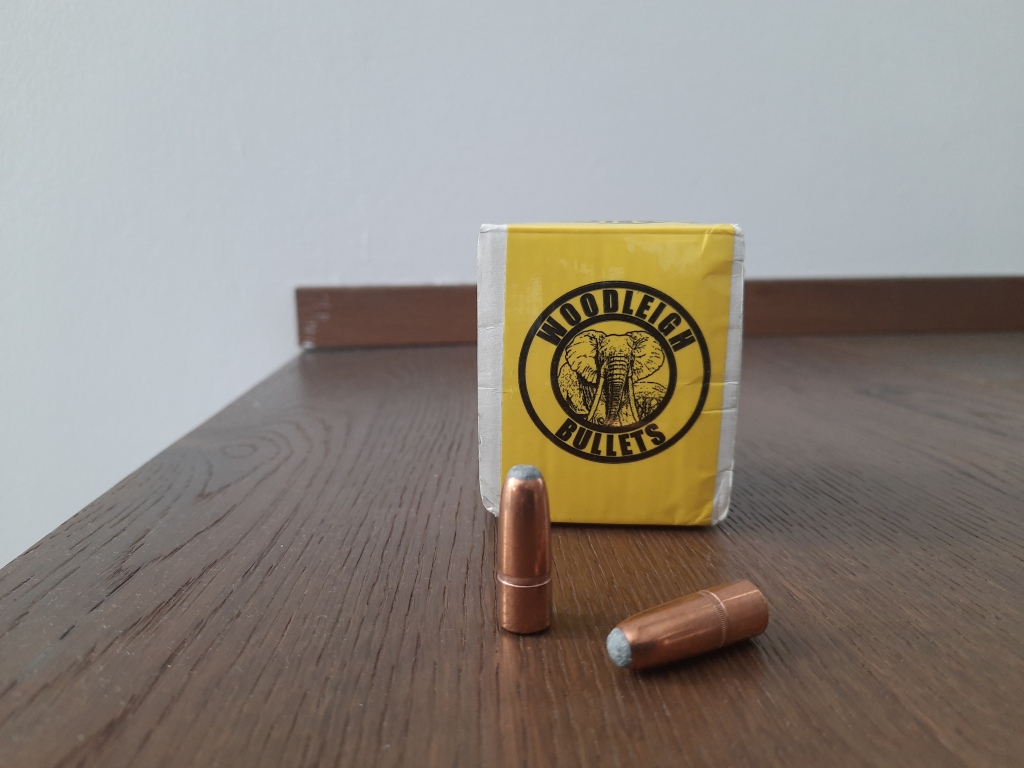
What a disappointment! My cartridge had an accurate soft charge, perfectly suitable for European games. We will never repeat it enough, checking feeding fluidity is fundamental, always take care of it, especially if you’re going to hunt dangerous games.
FMJ AND SOLID OGIVES.
Being suitable for African big game, we can consider these bullets: Full Metal Jackets, and solid bullets. FMJs are military bullets’ evolution for big game hunting.
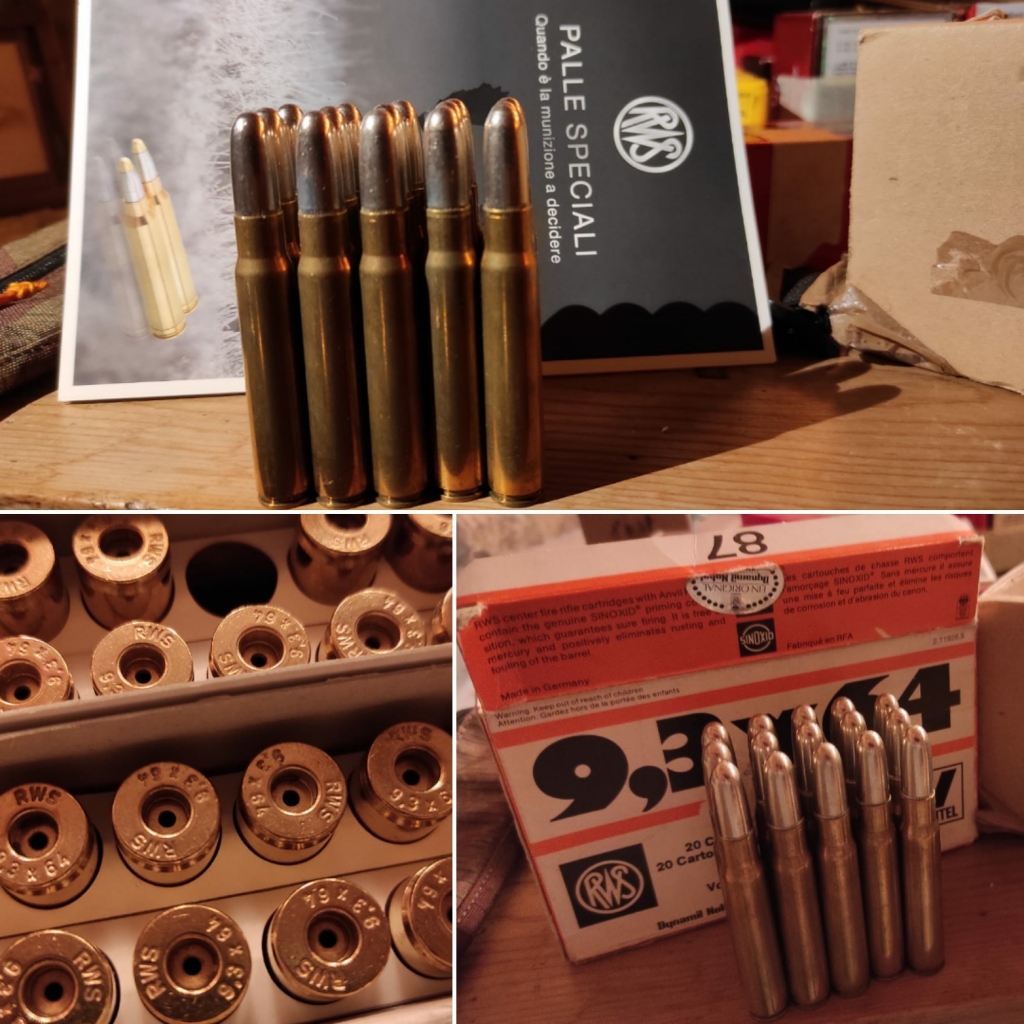
They normally have Round Nose profile, so to generate larger permanent cavity and to ensure straight penetration, avoiding deflection after violent impacts. Generally mantel and core aren’t welded: Mantel simply wraps completely around core, and is thick enough to prevent separation. Best manufacturers such as Woodleigh, usually design FMJs with the same shape and ballistic coefficient of soft point bullets of same weight. This ensures that both Soft Point and FMJ bullets can be used in the same weapon, with the same zeroing. Different structure will not obviously guarantee identical , but certainly very close, points of impact. This aspect is extremely important in Big Game Hunting. British doctrine recommended to use a Soft Point Bullet as first cartridge, followed by as many FMJs as possible. This modus operandi allows you to anchor the prey with first bullet, or at least to severely wound and finish it with fmjs, trying to obtain complete penetration into vitals or better deliberate CNC shot. This “doctrine” finds maximum application in Express rifles, where traditionally a Soft Point was loaded in the left barrel and an FMJ in the right one. The hunter was free to fire the best bullet by choosing the trigger. It seems trivial, but similar flexibility is not conceivable on any Bolt Action.
For several years now, Solids bullets have replaced armored bullets. These ogives are made with monomethal structures, usually in copper or other alloys. They are definitely non-deformable, designed to penetrate as deep as possible. Solid usually have Flat Nose so to generate larger permanent cavity and guarantee linear, absolute penetration. First solids didn’t have rings, so they completely adhered to rifling for entire bullet’s length. On more than one occasion this configuration generated overpressure and in some old express rifles rifling’s erosion was noticed, with inevitable loss in weapon accuracy. Subsequently, manufacturers wisely decided to use a slightly under-calibrated profile with rings (Banded): only a small part of the bullet kisses the rifling, with limited friction, controlled pressure and better precision. These bullets have partially changed rules, guaranteeing high performance even in relatively mild calibers. In top performing calibers, such as 9.3 × 64, increased the excellent performance. Unfortunately for them, continuous bullets evolution generated better performing monsters.
As always, the reference company is the Australian Woodleigh. Their research starts at the end of the 1970s, by an engenieer of italian origin . His studies led him to design the “Hidrostatically stabilized bullet”. Projectiles designed to generate immense damage on very large game, not dumping energy, but creating a strong shock wave inside game’s body: an energy column that precedes the bullet, digging a tunnel in flesh and bones. The “Hidros” are copper made and have typical banded design, like many copper alloy projectiles. Bullet is practically under-calibrated, and only rings touch the rifling. This aspect has been maniacally cared, since Woodleigh’s intent was to employ Hidros on old double rifles without ruining beauty and efficiency. Ogive’s top has a characteristic concave shape, where it’s possible to apply a plastic cap to improve feeding and external ballistics.
Bullet’s design, particularly the upper part, is responsible for sensational performances. Once penetrated, it generates a sort of low-pressure cavitation bubble, which is pushed by the bullet and inside which it “floats”, producing consistent hydrodynamic shock and a larger than solid bullets permanent cavity. Egress hole is typically bell-shaped, impressive sized, and usually characterized by massive bleeding. These bullets are revolutionary, real game Changers. Loaded on mild calibers, they cleanly kill games of considerable size, while large calibers, even at medium speed, became even more lethal.
The only drawback is bullet’s length, related to materials. If in old calibers with roomy cases, typically express rifles, it doesn’t normally generate any problems, in some bolt action’s calibers it could require precautions when developing load. These are sensational ogives, intended for special hunts.
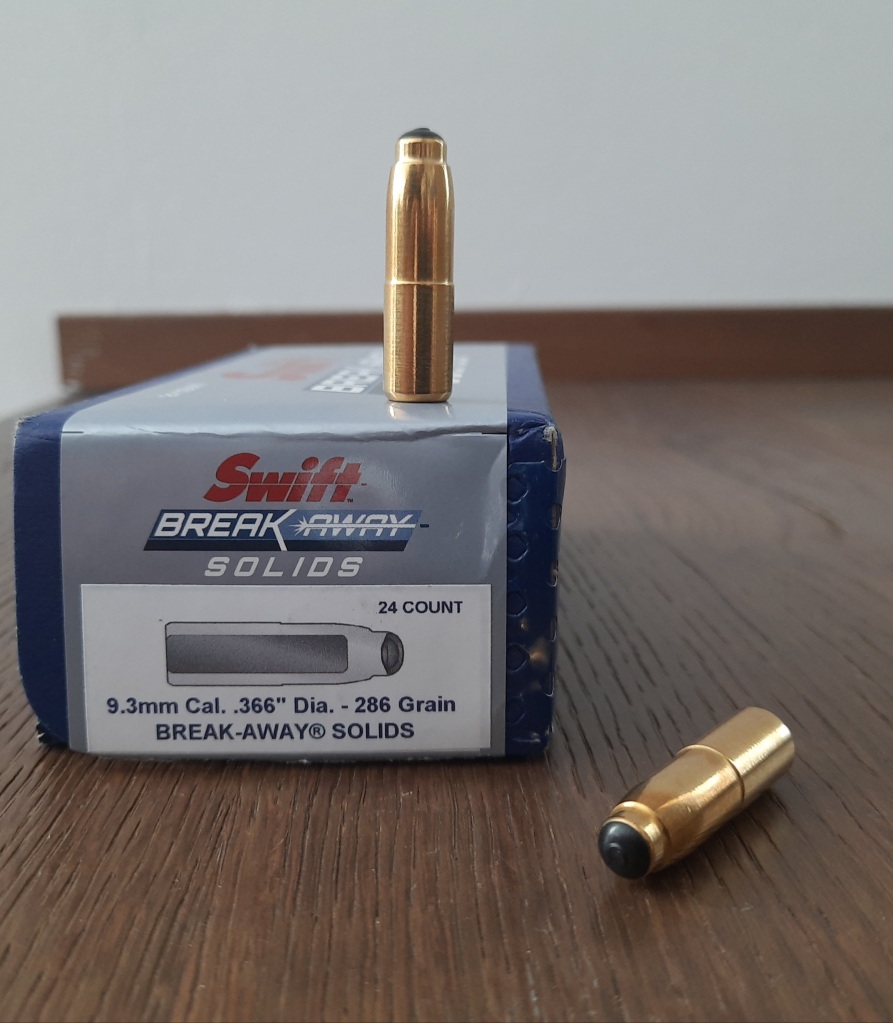
Latest bullets with similar design, in my opinion destined to leave a mark, are Swift’s Break Away Solid. These ogives are in some way Woodleigh’s HSBs evolution. They have lead core, while mantel is made with the same tough copper used for A-Frames. The upper part is concave, surmounted by a plastic cap, intended to improve feeding and ballistic. Performances are substantially similar to HSB, with the undoubted advantage of better specific weight, and the same A-Frame’s impact point.

Swift took particular care to design: bearing surface is the same in both bullets and external ballistics is virtually identical up to average Big Game Hunting distance. This aspect incredibly increases weapon’s flexibility, since you can use two different bullets with the same zeroing, hunting any kind of game with just one rifle.
They are undoubtedly destined to create a revolution in evolution, and they deserve a deepening. We will dedicate them an article in the future, trying to understand how effective they are in this caliber. A test never done before. stay tuned.
CONCLUSIONS .
A century after its birth, 9.3 × 64 Brenneke remains a successful experiment. Wilhelm’s jewel still has a faithful followers plethora, all fashinated by this ballistic system potential and constantly looking for new powders and ogives combinations to enhance its striking performance. Although inevitably walking on sunset boulevard, it’s still inspiration and starting point for new calibers. In 1999, Hornady and Steyr launched .376 Steyr a surprising new cartridge: based on 9.3×64 case slightly shortened and modified to accommodate a 9.5mm bullet, this little marvel was destined to be chambered in Steyr Scout carbines, ultimate Jeff Cooper’s “super scout” evolution. .375 bullet had been chosen to overcome legal restrictions imposed by some African countries, while the shortened 60 mm case still allowed excellent ballistics and advantageous short action. This weapon and cartridge combination exalted Cooper’s concept of flexibility. Hornady still offers two ammunition, 225-grain and 270-grain, both loaded with the proven Interlock bullet. Steyr occasionally produces a few guns chambered in this caliber. Surely this experiment, which should had deserved greater success, does not shine in ballistic firmament. Some factors didn’t help, including the global economic crisis that followed not many years after its launch. However, original work’s value remains unquestionable. If after a century, Brenneke’s work is still a starting point for new calibers, perhaps it would be worth reconsidering the project and pushing it a bit, revised and adapted to times.
Another godson of our caliber is the moderately known 6.5 Messner. Born by brass shortening and neck narrowing , the 6.5Messner was the first French-speaking magnum, born in 1996 by Alsatian Joseph Messner. Good on almost all major European and part of African game, it represents an excellent example of how a Wildcat can become a recognized and validated caliber according to CIP standards.
Other WildCats are the 8.5 × 64, designed by Lutz Moller, and the lesser-known 8 × 64 Mazon, invented by Alvaro Mazon.
There is also a .30 wildcat, the unknown .30 Hembrook Long.
These calibers, often pure stylistic exercises, are not and will never be destined to mass production, but nevertheless are interesting experiments that deserve admiration.
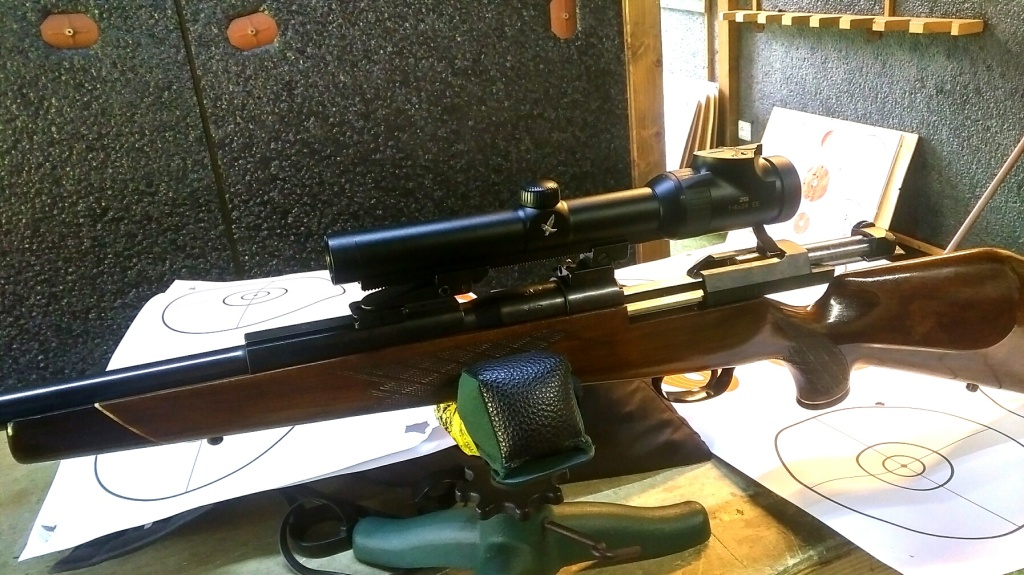
With a notable twist, in 2009 Russian army announced the adoption of 9.3 × 64 Brenneke as an anti-material ammunition. Chambered in the notable Dragunov, it is mainly used to penetrate light armor and let Russian Snipers to stop light armoured vehicles up to 600 meters. The simple fact that this powerful ammunition, born over a century ago, can be used in a semiautomatic rifle with simple and extremely reliable mechanics, shows how smart the original project was. This Short but powerful cartridge finds new youth in a field it was never conceived for, the military one.

The Glorious Brenneke’s Path is not over yet. If companies continue to believe in this centuries-old project, churning out modern ogives suitable for today’s hunters, we will see this star shine again. As an enthusiast I can only emphasize this ballistic system versatility, extreme precision and power that can be achieved with handloading and good range practice.
If you find a rifle in this spectacular caliber, try to picking it up, smelling woods and appreciating its lines. Perhaps you will feel adventure’s smell, of lands far away in time. Just imagine how many adventures has seen. If you will be fascinated, make it yours.
You will have a treasure in the rack.
Stay in touch with Mauser Italia:
https://www.facebook.com/groups/1100509527013603/?ref=shareAds